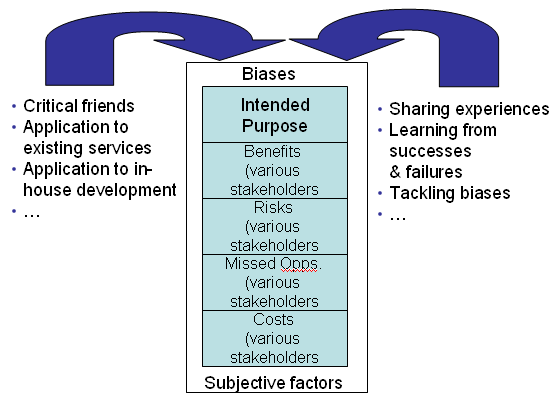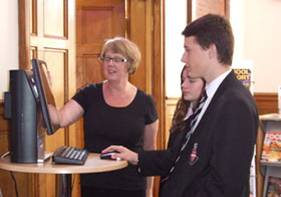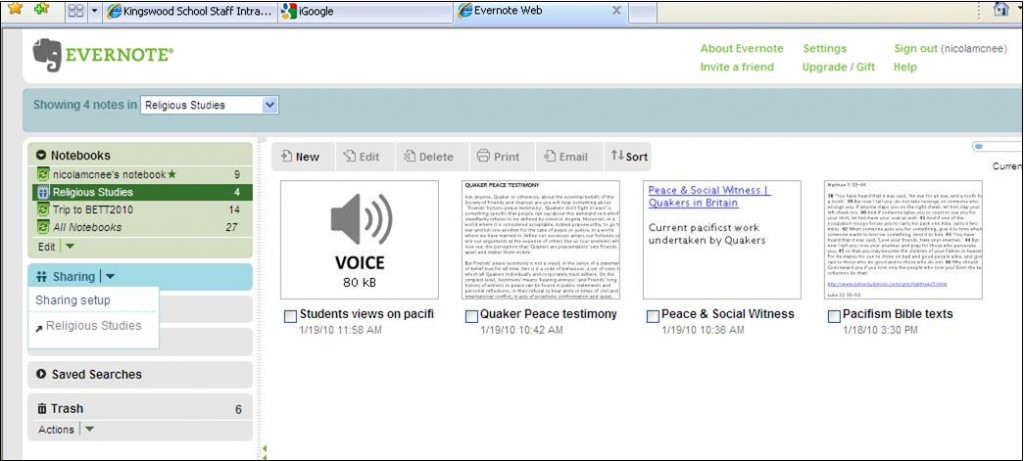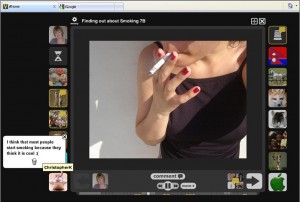In my recent blog post on my Talk at the MCG Spring Meeting 2009 I gave a brief summary of the talk on “Engaging With The Social Web: A Risks and Opportunities Framework” which I gave at the MCG Spring Meeting 2009 and included a video recording of the talk.
As promised in that post, I am today explaining in more detail what I mean by a risks and opportunities Framework.
The advocacy work, such as that described Mike Ellis and myself in a paper on “Web 2.0: How to Stop Thinking and Start Doing: Addressing Organisational Barriers” at the MW2007 conference, has now been widely accepted. The opportunities which can be provided by the Social Web are now widely acknowledged, as we heard in a number of presentations form staff from the Bath Cultural Heritage Service Department.
As I explained in a paper on “Time To Stop Doing and Start Thinking: A Framework For Exploiting Web 2.0 Service” presented at this year’s MW2009 conference We know need to address a range of concerns including those which have been raised at various workshops organised by UKOLN and delivered through MLA Regional Agencies and Renaissance Hubs. Such concerns include a lack of understanding (of what the Social Web is about); concerns over legal issues, technical challenges (such as interoperability, reliability issues), business challenges (such as sustainability) and related resourcing issues.
It may be useful to consider the Gartner Hype curve in the context of exploitation of Social Web services. The early adopters have, in many cases, been successful in promoting new technologies, such as, initially the borad concept of Web 2.0 and, more recently, specific examples such as Twitter. But we now need to attempt to reshape the Gartner curve, by managing expectations and deploying a variety of approaches in order to avoid the ‘trough of despair’ and achieve sustainability and effective services.
We firstly need to ensure that we have a realistic view of the various emerging Social Web services. Simply suggesting that a setting up, for example a Ning social networking environment will provide a sustainable community isn’t the case, and there are enough examples of empty social networking environments which can be used to demonstrate this. However we also need to remember that it’s not just a question of the numbers of active users which defines success: there will be examples of social networks with small numbers of users (such as, perhaps, a committee) who feel that the environment satisfies their needs by providing a cost-effective solution. We must remember that there is a context to any success criteria.
We do need to consider the various legal issues. But we need to remember that as the law may not reflect technical possibilities, it may sometimes it may be possible to exploit technologies in ways in which ‘reasonable measures’ clauses in legislation may permit. The Disability Discrimination Act and its application to the IT environment, for example, provides an interesting case study. Does the video recording of my talk at the MCG Spring Meeting fall foul of disability legislation, as there is no trasncipt available? Or could I argue that the video recording enhances access for people who could not attend the meeting (and we have evidence that that is the case)? And doesn’t this blog post provide an equivalent (indeed richer) experience than is provided on the video? Indeed could it not be argued that a failure to provide videos of the other speakers contravenes disability legislation? After all, it is now very easy to record talks (as I demonstrated) and make them available online.
We also need to address the issues of sustainability and interoperability. Two years ago, I frew parallels between Web 2.0 services such as Google and Yahoo! and the banks. ‘Banks might become bankrupt‘ I argued ‘But they normally don’t, so let’s not worry too much‘. These days I say ‘Banks do become bankrupt, but that doesn’t mean we don’t use banks and keep out money under our mattress. Rather we take a risk management approach and ensure we don’t have more than the £30,000 limit (I think) which is guareanteed by the government‘. We need to develop similar risk assessment and risk management approachs to our use of Social Web services.
In this post I will not expand on the approaches to addressing the interoperability anbd sustsinability issues in any details, or related issues regarding gaining a better understanding of the Social Web and addressing the organisational and cultural barriers we are likely to encounter, especially in public sector organisations – I’ll simply mention the various UKOLN workshops we’ve delivered over the past few years and the briefing documents which seek to address such issues.
A variety of deployment strategies have been discussed at various workshops (e.g. identifying the low-hanging fruit; supporting the enthusiasts, etc.) For now, however I wish to address three key aspects of the framework I have been working on: a risks and opportunities assessment and management approach; exploitation of Critical Friends and friendly critics and a culture of openness.
As described in the JISC infoNet Risk Management infoKit “In education, as in any other environment, you can’t decide not to take risks: that simply isn’t an option in today’s world. All of us take risks and it’s a question of which risks we take“. Our organisations will need to take risks, and we need to acknowledge the difficulties of changing a culture which, in many public sector organisations, is risk averse. We also need to apply a risk assessment approach to in-house development work as well as exploitation of third-party services. We should remember the experience of the UK eUniversity when £62 million pounds of public money was invested in the development of a national e-University. In 2004, however, we learnt that HEFCE had pulled the plug on the E-University. We need to ensure that we avoid repeating such mistakes in other areas, especially as people are predicting significant changes in the management of, and associated levels of funding, after the next election.
An approach I have been exploring recently is use of Critical Friends. I first came across this in a JISC context in order to ensure that reality checks are in place in areas of innovation. It seems that Critical Friends: (a) have a mission to make projects succeed; (b) balance informal approach with critical eye; (c) maintain confidentiality, frankness, sensitivity & independence and (d) may have a funded role. In the absence of Critical Friends innovative developments may benefit from ‘friendly critics’ who have no formal responsibilities but are still willing to discuss and engage and will appreciate sensitivities, constraints, etc. Ensuring that such mechanisms are in place will help to identify possible unexpected risks and dangers and minimise attacks at a later date from unfriendly critics & hostile opponents.
 The risks and opportunities framework was first developed as A Framework For Making Use of Facebook. An updated version was described in a post on the UK Web Focus blog and the accompanying diagram is shown here.
The risks and opportunities framework was first developed as A Framework For Making Use of Facebook. An updated version was described in a post on the UK Web Focus blog and the accompanying diagram is shown here.
In brief it is proposed that decisions on use of Social Web services should be informed by documentation on:
- The intended purpose of the service
- The perceived benefits for various stakeholders
- The missed opportunities for the various stakeholders of not using the service
- The costs of using the service for the various stakeholders.
It should be acknowledged that such documentation is likely to reflect an organisational and organisational and personal biases and other subjective factors.
In order to maximise the benefits of this approach, external input should be encouraged, whether through the formal use of Critical Friends or by inviting friendly critics to give feedback on proposed plans.
In public sectors organisations in particular we would expect this approach to be taken in a culture of openness and sharing. The sharing of experiences (both good and, as Mia Ridge has recently described, bad) happens already on various mailing lists and at events and conferences. But we should be doing more of this and at an earlier stage in development work.
We may, indeed, find ourselves in the situation in which FOI requests will be made in order to provide public access to information on networked services, as has been seen with the FOI request for information on the total number of objects in the Natural History Museum’s collection. In this example the National History Museum was able to report “a total holding of 75.6 million items for the entire Museum“.
We know from the recent stories about MPs expense claims that there can be real dangers in attempting to hide information from the public. And once legislation or pressure from the media and the public forces public bodies to provide such data we now find that the whistle-blowers aren’t just newspapers (often with an axe to grind) but the development community who now can use various technologies to visualise how public sector funding is being used (or misused, as can be seen from Tony Hirst’s various mashups of MPs expense claims).
The benefits of being open about development work shoiuld be self-evident. And It is worth mentioning Nick Moyes’ recent post on this blog on “When Peregrines Come To Town” in which he described some unexpected problems in deploying a very popular service:
So great were our webstats submitted under the now-superceded system of “Best Value Performance Indicators” reported by local authorities, that the Audit Commission even questioned their veracity. After much high level debate they declared our figures unsuitable for reflecting website usages by museums. Had it been a stuffed peregrine, fine. But this was a live bird – so how could it be seen as valid for a museum to report on that, they argued. A fair point, perhaps. After all, “Best Value” was designed to allow for fair comparison to be drawn between similar types of service across different local authorities, so maybe exclusion was sensible. But when it was suggested locally that this decision might put the viability of the whole project into question, then alarm bells did begin to ring. I feared this could be a case of the statistics-gathering tail wagging the audience-focussed dog. But common sense prevailed and we’ve since been fully supported in our work, especially so after being able to demonstrate that we draw many thousands more visitors into our main websites each summer
And rather than regarding such FOI requests as a threat, the museum sector in particular should regard this as an ideal opportunity to build on a well-established tradition of openness and use figures (such as the Natural History Museum’s “total holding of 75.6 million items for the entire Museum” as an opportunity to promote one’s own contributions to the digital environment. And if more museums were making their data available in an open and reusable way the entire sector would be well-pusitioned to exploit the opportunies provided by the ubiquity of Web 2.0 and the Social Web.




